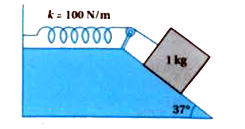Explain propagation of sound waves in air.Solution in Gujrati
As the sound wave passes through air, compression and expansion of small regions of air medium take place periodically turn by turn, along the direction of propagation of wave. A small region of air medium in which air particles tend to move towards each other, causing increase in density (ΔP) and hence increase in pressure (ΔP), because according to ideal gas equation we have PV=nRT⇒P(Mρ)=nRT(∵ρ=MV)⇒P=(nRTM)ρ⇒
At constant temperature ΔP∝ΔP.

In such a high prcssure region, where density is increased temporarily, "Condensation" or "Compression" is said to be formed. It is shown by symbol C in above figure.
Now, since pressure is force exerted normally (perpendicularly) on unit area, restoring force is developed in above region, which is directly proportional to displacement of a particle from its mean position. Consequently, air particles in above region tend to move outward (parallel to direction of propagation of wave) towards adjoining region on left & right, causing compressions in them. When this happens, density of air in the middle region (from where air particles have moved out) decreases temporarily.
In such a low pressure region, "rarefaction" or "expansion" is said to have be formed. It is shown by symbol R in above figure.
As explained above, each small region of air medium coming successively in a direction away from origin of sound, undergoes compression and rarefaction periodically. This is how disturbance moves away from source of sound, which indicates propagation of sound waves which are mechanical and longitudinal.
Topper's Solved these Questions
- WAVESBOOK - KUMAR PRAKASHANCHAPTER - WAVESEXERCISE - SECTION-A TRY YOUR SELF
63 Videos
- WAVESBOOK - KUMAR PRAKASHANCHAPTER - WAVESEXERCISE - SECTION-B (Numericals) (Numerical From Textual Illustrations)
14 Videos
- UNITS AND MEASUREMENTBOOK - KUMAR PRAKASHANCHAPTER - UNITS AND MEASUREMENTEXERCISE - Section -F (Questions from Module )
20 Videos
- WORK, ENERGY AND POWER BOOK - KUMAR PRAKASHANCHAPTER - WORK, ENERGY AND POWER EXERCISE - QUESTION PAPER (SECTION - D)
1 Video
Similar Questions
What are called waves ? Mention their importance.
View SolutionGiven below are some examples of wave motion. State in each case if the wave motion is transverse, longitudinal or a combination of both:
(a) Motion of a kink in a longitudinal spring produced by displacing one end of the spring sideways.
(b) Waves produced in a cylinder containing a liquid by moving its piston back and forth.
(c ) Waves produced by a motorboat sailing in water.
(d) Ultrasonic waves in air produced by a vibrating quartz crystal.
View SolutionIf the error in measurement of radius of a shpere is 2% then the error in determination of volume of the sphere will be …………
View SolutionA 1 kg block situated on a rough incline is connected to a spring constant 100Nm−1 as shown in figure . The block is released from rest with the spring in the unstretched position . The block moves 10 cm down the incline before coming to rest . Find the coefficient of friction between the block and the incline .Assume that the spring has a negligible mass and the pulley is frictionless.

View SolutionPropagation Of Sound Waves
View SolutionA sound wave travelling in air is made to propagate through a liquid such that the velocity of sound is quadrupled. If the frequency of the sound wave is constant, find the change in the wavelength of the sound wave
View SolutionExplain the propagation of sound in air.
View SolutionDuring propagation of sound wave through air medium
View SolutionThe sound wave propagates through
View SolutionWhat is the nature of the thermal change in air, when a sound wave propagates through it ?
View SolutionThe phenomenon of sound propagation in air is
View SolutionIts particles when sound waves propagate in the air
View SolutionOn the basis of spring model, explain the propagation of a sound in air.
View SolutionMaterial medium is essential for propagation of sound waves'. Explain the experiment with diagram .
View SolutionExplain propagation of sound waves in solids.
View Solution
